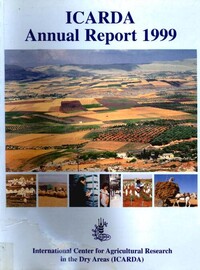ICARDA Annual Report 1999

Authors:
Agricultural systems in dry areas are dynamic and face increasing demands due to the globalization of economies and urban market development. In 1999, the Fourth External Program and Management Review (EPMR) panel assessed ICARDA's effectiveness in adapting to these challenges, concluding that the center had transformed significantly and was well-prepared for future challenges. The panel emphasized the crucial role of water management, as water—not land—is the primary limitation for agricultural production in Central and West Asia and North Africa (CWANA).
ICARDA's research has shown that supplemental irrigation (SI) can lead to substantial increases in rainfed wheat production. Studies indicate that combining SI with rain is more efficient than full irrigation. The Center is also leveraging Geographic Information Systems (GIS) to improve water-use efficiency and develop an Agroecological Atlas of Syria, while assisting Morocco with land suitability mapping.
Drought is a major factor in crop improvement, and ICARDA is developing drought-tolerant barley, wheat, and legumes with national partners. Over half of the barley and lentil varieties released in developing countries from 1980 to 1999 originated from ICARDA's germplasm.
In Central Asia, ICARDA is implementing projects like 'Integrated Feed and Livestock Production in the Steppe of Central Asia,' crucial for addressing the breakdown of traditional livestock systems. The 'Conservation and Sustainable Use of Dryland Agrobiodiversity’ project, involving Jordan, Lebanon, Syria, and Palestine, aims to preserve local crop varieties with community participation.
The EPMR panel reaffirmed ICARDA's role in combating poverty and malnutrition, highlighting that two billion people globally are malnourished, with 700 million living on less than $2 per day. ICARDA continues to provide scientific solutions to alleviate these challenges, emphasizing its critical relevance in the region since its founding in 1977.
